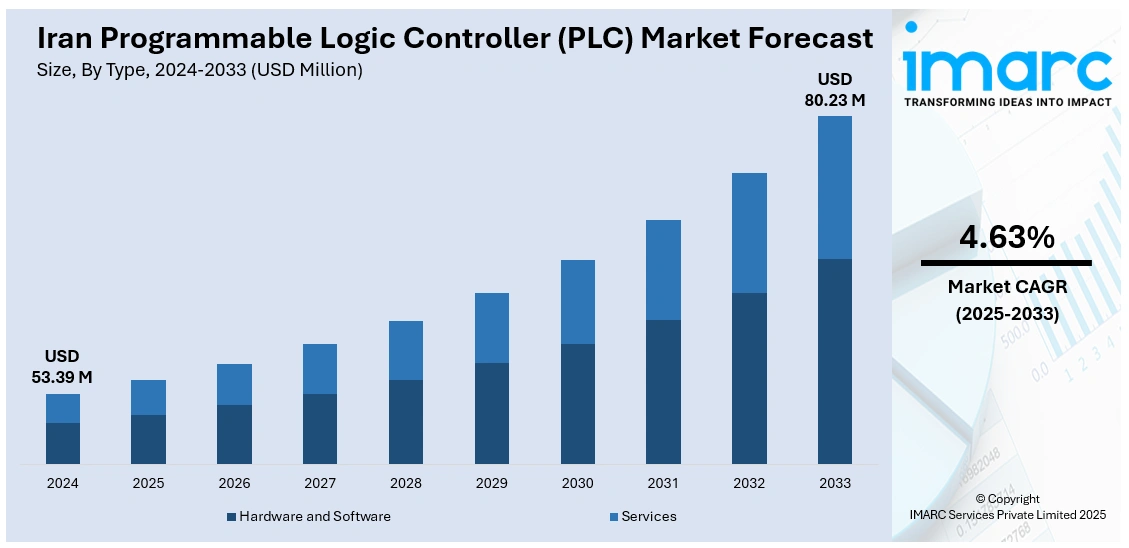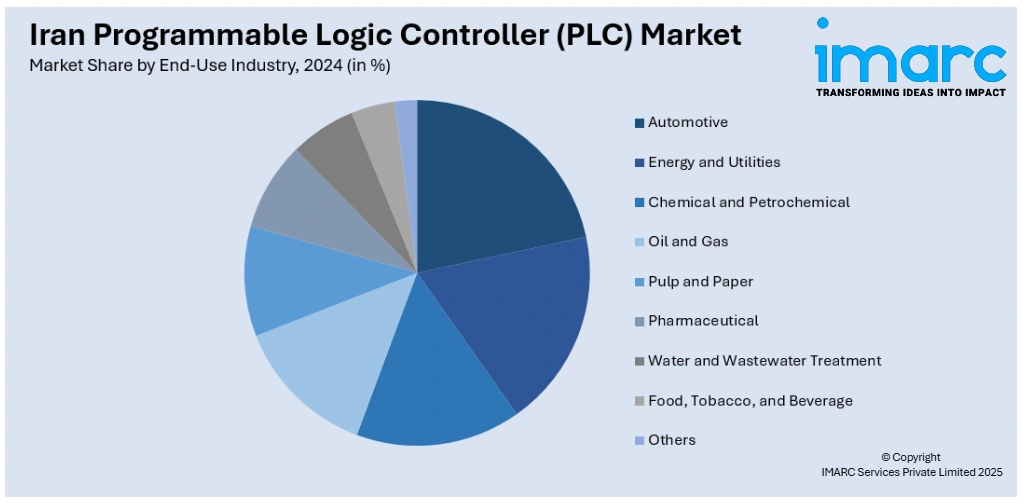
Iran Programmable Logic Controller (PLC) Market Size, Share, Trends and Forecast by Type, End-Use Industry, and Region, 2025-2033
Iran Programmable Logic Controller (PLC) Market Overview:
The Iran programmable logic controller (PLC) market size reached USD 53.39 Million in 2024. Looking forward, IMARC Group expects the market to reach USD 80.23 Million by 2033, exhibiting a growth rate (CAGR) of 4.63% during 2025-2033. Iran's focus on renewable energy, agricultural automation, and industrial modernization is driving the demand for PLCs. They are essential in managing renewable energy systems, optimizing agricultural processes, and supporting industrial automation. Government investments and regulatory support are influencing the Iran programmable logic controller (PLC) market share to enhance efficiency, sustainability, and economic growth.
|
Report Attribute
|
Key Statistics
|
|---|---|
|
Base Year
|
2024
|
|
Forecast Years
|
2025-2033
|
|
Historical Years
|
2019-2024
|
| Market Size in 2024 | USD 53.39 Million |
| Market Forecast in 2033 | USD 80.23 Million |
| Market Growth Rate 2025-2033 | 4.63% |
Iran Programmable Logic Controller (PLC) Market Trends:
Government Investments and Regulatory Support
The emphasis of the governing authority on updating and diversifying its economy is resulting in a strong prioritization of industrial development, especially in the energy, manufacturing, and infrastructure areas. Strategies aimed at encouraging the use of automation technologies, such as PLCs, are critical to this approach. In 2025, Iran's Ministry of Energy initiated 26 significant electricity infrastructure projects in Mazandaran province, estimated at $120 million. These initiatives, encompassing the improvement of transmission lines, substations, and the implementation of smart grid technology, seek to bolster energy security and capacity. Such efforts highlight the dedication of governing body in incorporating advanced automation technologies, such as PLCs, into essential infrastructure projects. Government-supported initiatives for domestic PLC production, along with incentives for international collaborations, further contribute to the Iran programmable logic controller (PLC) market growth. By investing in the digital transformation of its industries, Iran is witnessing a significant rise in the adoption of PLC systems nationwide, aiding both technological modernization and economic growth.

To get more information on this market, Request Sample
Integration with Renewable Energy Systems
Iran's heightened emphasis on renewable energy, especially solar and wind, is driving the need for PLCs to oversee these systems. PLCs play a vital role in overseeing, managing, and enhancing energy production and distribution in renewable energy facilities. With Iran making significant investments in renewable energy infrastructure to broaden its energy portfolio, the importance of PLCs in maintaining the efficiency and reliability of solar and wind energy systems grows increasingly vital. These control systems are essential for overseeing renewable energy integration, such as load balancing, energy storage, and grid connectivity. In 2025, Iran introduced 400 MW of additional solar capacity via nine projects in Yazd, Fars, Markazi, and Isfahan provinces, with the largest being the 200 MW Yazd solar facility. These efforts focus on alleviating energy deficits and increasing Iran's renewable energy potential, aligning with a wider objective of incorporating 10,000 MW of renewable energy by 2029. This increase in renewable energy capacity is driving the demand for PLCs, as they are essential for automating and optimizing the management of energy generation and distribution systems.
Demand for Automation in Agricultural Sector
Iran's farming sector is progressively integrating automation technologies, such as PLCs, to improve efficiency and address the growing needs of the populace. PLCs are utilized in multiple applications, including automating irrigation systems, controlling temperature in greenhouses, and overseeing livestock management. These systems help enhance resource utilization, minimize waste, and improve uniformity in agricultural output. The requirement for PLCs is increasing as the nation emphasizes enhancing food production efficiency and adopting sustainable agricultural methods. In 2025, within the third phase of its national crop pattern reform, Iran's Ministry of Agriculture initiated a smart farming system aimed at enhancing water efficiency and increasing crop productivity. This program, featuring more than 100 smart irrigation pilot projects, incorporates real-time farm monitoring, showcasing the government's dedication to updating agricultural practices. With Iran's ongoing initiatives to modernize agriculture for domestic and international markets, the adoption of PLCs is rising in Iran.
Iran Programmable Logic Controller (PLC) Market Segmentation:
IMARC Group provides an analysis of the key trends in each segment of the market, along with forecasts at the country and regional levels for 2025-2033. Our report has categorized the market based on type and end-use industry.
Type Insights:
- Hardware and Software
- Large PLC
- Nano PLC
- Small PLC
- Medium PLC
- Others
- Services
The report has provided a detailed breakup and analysis of the market based on the type. This includes hardware and software (large PLC, nano PLC, small PLC, medium PLC, and others) and services.
End-Use Industry Insights:

- Automotive
- Energy and Utilities
- Chemical and Petrochemical
- Oil and Gas
- Pulp and Paper
- Pharmaceutical
- Water and Wastewater Treatment
- Food, Tobacco, and Beverage
- Others
A detailed breakup and analysis of the market based on the end-use industry have also been provided in the report. This includes automotive, energy and utilities, chemical and petrochemical, oil and gas, pulp and paper, pharmaceutical, water and wastewater treatment, food, tobacco, and beverage, and others.
Regional Insights:
- Tehran
- Khuzestan
- Bushehr
- Esfahan
- Khorasan
- Others
The report has also provided a comprehensive analysis of all the major regional markets, which include Tehran, Khuzestan, Bushehr, Esfahan, Khorasan, and others.
Competitive Landscape:
The market research report has also provided a comprehensive analysis of the competitive landscape. Competitive analysis such as market structure, key player positioning, top winning strategies, competitive dashboard, and company evaluation quadrant has been covered in the report. Also, detailed profiles of all major companies have been provided.
Iran Programmable Logic Controller (PLC) Market Report Coverage:
| Report Features | Details |
|---|---|
| Base Year of the Analysis | 2024 |
| Historical Period | 2019-2024 |
| Forecast Period | 2025-2033 |
| Units | Million USD |
| Scope of the Report |
Exploration of Historical Trends and Market Outlook, Industry Catalysts and Challenges, Segment-Wise Historical and Future Market Assessment:
|
| Types Covered |
|
| End-Use Industries Covered | Automotive, Energy and Utilities, Chemical and Petrochemical, Oil and Gas, Pulp and Paper, Pharmaceutical, Water and Wastewater Treatment, Food, Tobacco, and Beverage, Others |
| Regions Covered | Tehran, Khuzestan, Bushehr, Esfahan, Khorasan, Others |
| Customization Scope | 10% Free Customization |
| Post-Sale Analyst Support | 10-12 Weeks |
| Delivery Format | PDF and Excel through Email (We can also provide the editable version of the report in PPT/Word format on special request) |
Key Questions Answered in This Report:
- How has the Iran programmable logic controller (PLC) market performed so far and how will it perform in the coming years?
- What is the breakup of the Iran programmable logic controller (PLC) market on the basis of type?
- What is the breakup of the Iran programmable logic controller (PLC) market on the basis of end-use industry?
- What is the breakup of the Iran programmable logic controller (PLC) market on the basis of region?
- What are the various stages in the value chain of the Iran programmable logic controller (PLC) market?
- What are the key driving factors and challenges in the Iran programmable logic controller (PLC) market?
- What is the structure of the Iran programmable logic controller (PLC) market and who are the key players?
- What is the degree of competition in the Iran programmable logic controller (PLC) market?
Key Benefits for Stakeholders:
- IMARC’s industry report offers a comprehensive quantitative analysis of various market segments, historical and current market trends, market forecasts, and dynamics of the Iran programmable logic controller (PLC) market from 2019-2033.
- The research report provides the latest information on the market drivers, challenges, and opportunities in the Iran programmable logic controller (PLC) market.
- Porter's five forces analysis assist stakeholders in assessing the impact of new entrants, competitive rivalry, supplier power, buyer power, and the threat of substitution. It helps stakeholders to analyze the level of competition within the Iran programmable logic controller (PLC) industry and its attractiveness.
- Competitive landscape allows stakeholders to understand their competitive environment and provides an insight into the current positions of key players in the market.
Need more help?
- Speak to our experienced analysts for insights on the current market scenarios.
- Include additional segments and countries to customize the report as per your requirement.
- Gain an unparalleled competitive advantage in your domain by understanding how to utilize the report and positively impacting your operations and revenue.
- For further assistance, please connect with our analysts.
 Request Customization
Request Customization
 Speak to an Analyst
Speak to an Analyst
 Request Brochure
Request Brochure
 Inquire Before Buying
Inquire Before Buying




.webp)




.webp)












